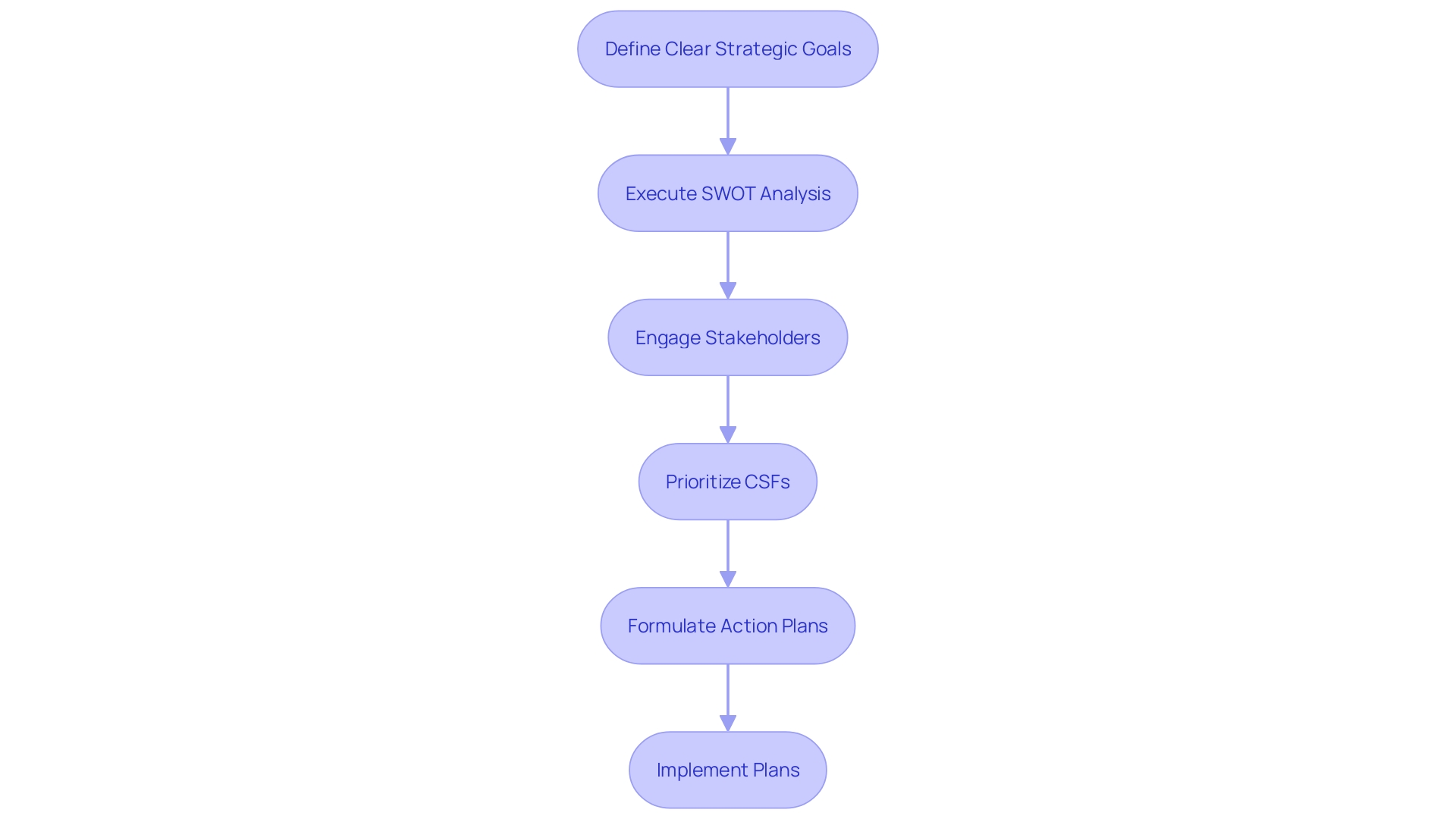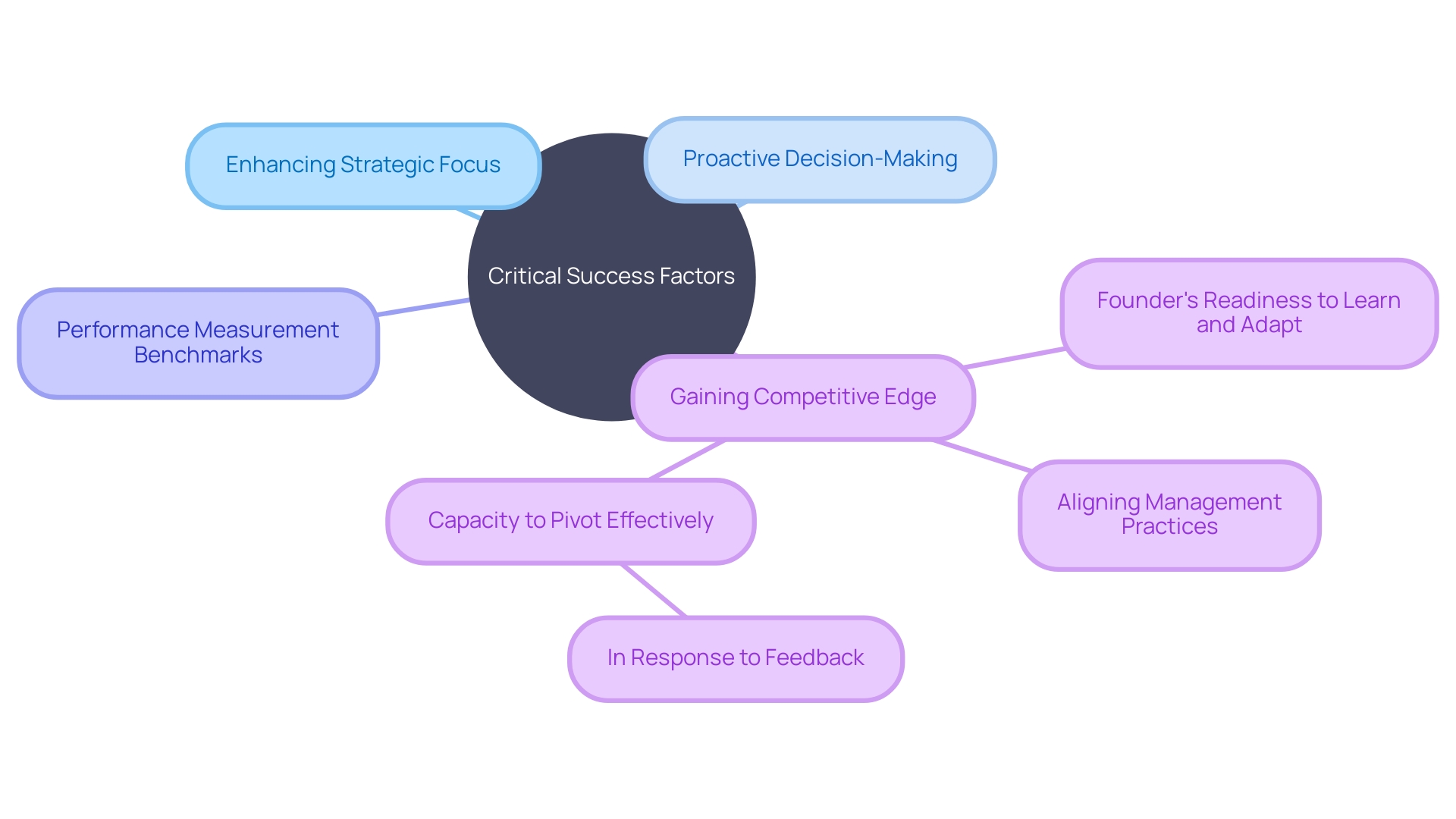Introduction
Understanding the critical success factors (CSFs) for a business or project is pivotal for steering towards success. These elements serve as the foundation for strategic planning and resource allocation, essential for navigating a company's journey to its goals. CSFs are dynamic and can differ widely across industries, encompassing a range of areas such as market demand, customer satisfaction, and innovation.
In this article, we will explore the definition and importance of critical success factors, providing insights from experienced business leaders and industry experts. We will also delve into the steps to identify and implement CSFs, offering practical guidance for organizations. Additionally, we will examine examples of CSFs in various industries, highlighting their significance in driving business growth and competitiveness.
Furthermore, we will discuss the benefits of identifying and using CSFs, including enhancing strategic focus and alignment, proactive decision-making, and gaining a competitive edge. We will also share best practices for implementing CSFs, emphasizing the involvement of key stakeholders, regular review and adaptation, effective communication, and performance management integration.
Lastly, we will address common challenges faced in implementing CSFs and provide solutions to overcome them. From achieving alignment and clarity to overcoming resistance to change, measuring and monitoring progress, dealing with resource constraints, and staying agile and adaptable, we will equip organizations with strategies to effectively manage their CSFs and pave the way for sustained success and growth.
Join us on this journey as we uncover the key to unlocking business success through critical success factors.
Definition and Importance of Critical Success Factors
Understanding the critical success factors (CSFs) for a business or project is pivotal for steering towards success. These elements serve as the foundation for strategic planning and resource allocation, essential for navigating a company's journey to its goals. CSFs are dynamic and can differ widely across industries, encompassing a range of areas such as market demand, customer satisfaction, and innovation.
In the rapidly evolving healthcare sector, for instance, the importance of CSFs is underscored by the experiences of startup entrepreneurs in the medical field. Insights from a seasoned business development leader with three decades in healthcare highlight that while certain personality traits like grit and confidence are beneficial, tangible business factors are equally critical for a successful exit strategy. These factors include acquisition, initial public offerings (IPOs), lucrative licensing or partnerships, and forming strategic alliances.
'The Most Important Business Book of the Year: How Big Things Get Done' emphasizes the readiness of founders to learn and adapt as a key factor. An MBA student specializing in Finance and Sustainability further identifies value drivers, both quantitative, such as revenue growth and cost management, and qualitative, like customer satisfaction and brand reputation, as instrumental to business success.
Moreover, the ability to pivot and adapt in response to customer and team feedback is vital for avoiding costly missteps. This adaptability can mean the difference between a merger or acquisition that adds value and one that fails to meet expectations. Thus, a well-organized process for implementing changes is indispensable.
Finally, successful business outcomes are often backed by compelling sales skills and thorough preparation. Entrepreneurs must be adept at selling their vision to customers, investors, and partners to thrive in today's competitive marketplace.
Steps to Identify and Implement Critical Success Factors
- Begin with defining clear strategic goals for your organization, pinpointing exactly what you aim to achieve and the outcomes critical for your success.
- Execute an in-depth SWOT analysis to uncover your organization's strengths, weaknesses, opportunities, and threats, which will illuminate the crucial areas for CSF identification.
- Engage a diverse group of stakeholders, from executives and managers to front-line employees and customers, to garner a comprehensive set of perspectives and insights that are essential for accurately determining CSFs.
- With the CSFs identified, prioritize them based on their potential impact on your strategic goals, focusing your resources on the elements with the greatest influence.
- Formulate detailed action plans for each CSF, defining specific initiatives, measurable goals, and clear timelines to ensure they are effectively addressed.
- Implement these plans with diligence, continuously monitoring their progress and adjusting as necessary to maintain alignment with your organization's overarching objectives.

Examples of Critical Success Factors in Various Industries
In various industries, identifying and mastering critical success factors (CSFs) is central to business growth and competitiveness. For instance, in the retail sector, companies thrive by adeptly managing inventory, fostering customer loyalty, seamlessly integrating online and offline channels, and implementing strategic pricing. The technology industry, on the other hand, demands continual innovation, exceptional product quality, rapid market delivery, customer satisfaction, and robust protection of intellectual property.
Healthcare businesses, influenced by insights from seasoned industry veterans, recognize the significance of patient safety, superior clinical outcomes, adherence to regulations, efficient resource use, and clear patient communication as pillars of success. Similarly, manufacturing firms' vitality hinges on efficient production, supply chain excellence, uncompromised product quality, stringent cost management, and the implementation of lean manufacturing techniques. In the financial services arena, paramount importance is placed on risk mitigation, regulatory adherence, earning customer trust, maintaining solid financial performance, and astute asset management.
These industry-specific CSFs, when strategically addressed, can lead to various forms of successful business outcomes, such as acquisitions that offer returns to investors, IPOs that provide capital influx, lucrative licensing or partnerships, and the formation of strategic alliances, all of which signify prosperous growth or exits. With the correct application of industrial marketing strategies, even small to mid-sized manufacturing companies can overcome resource limitations, employing cost-effective content marketing to engage audiences and demonstrate expertise.
Benefits of Identifying and Using Critical Success Factors
Harnessing Critical Success Factors (CSFs) can propel an organization towards its goals with remarkable benefits. Key among these is enhancing strategic focus and alignment, ensuring that efforts and resources are directed towards pivotal areas that can drive successful outcomes. The recognition of CSFs leads to more astute resource allocation, allowing organizations to channel investments and efforts into high-impact initiatives.
Proactive decision-making is another advantage of identifying CSFs, as they shed light on which factors demand immediate attention, thus enabling organizations to circumvent potential obstacles. Furthermore, CSFs provide a framework for measuring performance, offering benchmarks that can reveal both achievements and areas needing refinement.
Lastly, mastery in leveraging CSFs can endow an organization with a competitive edge. By concentrating on elements that distinguish them from competitors, companies can deliver superior value to their customers and secure a prominent position in the marketplace. For instance, as noted in the book 'How Big Things Get Done,' a founder's readiness to learn and adapt is crucial for success.
Similarly, McKinsey research underscores the importance of aligning management practices, including establishing a common purpose, to drive organizational health and sustainability.
Moreover, the capacity to pivot effectively in response to feedback from employees and customers, as suggested by business development leaders, is essential for executing strategic changes successfully. This adaptability, paired with rigorous performance evaluation, positions companies to thrive in dynamic business environments.

Best Practices for Implementing Critical Success Factors
-
To ensure that Critical Success Factors (CSFs) are embraced and effectively implemented, it is essential to involve key stakeholders from the outset. By doing so, you foster a sense of shared ownership and alignment of goals, as exemplified in a technical implementation case where a user-focused technical stack was chosen to enhance user experience and SEO strategies were tailored to outperform direct competitors.
-
The dynamic nature of business necessitates that CSFs are not treated as fixed entities. Just as a hotel company updated their foundational tools and strategies for effective advertising, your CSFs should be regularly reviewed and adapted to the current business climate and strategic objectives.
-
Communication is key in ensuring that CSFs are understood and supported across your organization. This is akin to educating stakeholders about the importance of trust and psychological safety, which are foundational to high-performing teams, as highlighted by Lencioni’s and Project Aristotle’s research.
-
To translate CSFs into tangible outcomes, integrate them into your performance management framework. Linking CSs to specific metrics and KPIs, much like the model registry concept for AI applications, can enhance accountability and drive performance improvements.
-
Lastly, cultivating a culture of continuous improvement is vital for staying competitive. By encouraging learning and adaptability, you can ensure that your organization remains agile and responsive to change, similar to how educational institutions like Somerset Academies of Texas have streamlined their processes for sustained success.

Common Challenges and Solutions
Challenges in implementing Critical Success Factors (CSFs) can arise due to various issues that businesses may encounter. Here are some of the challenges and potential solutions:
-
Alignment and Clarity Issues: Achieving clarity and alignment on CSFs within an organization is vital. This can be accomplished through effective communication, engagement of key stakeholders, and fostering a shared understanding of CSFs, much like the example of a leading Chilean retailer which faced difficulties in retaining and recruiting talent due to rapid growth. They addressed this by establishing a dedicated Talent area, demonstrating the importance of alignment in achieving business objectives.
-
Overcoming Resistance to Change: Changes in processes, systems, and behaviors are often met with resistance. To mitigate this, businesses can adopt effective change management strategies. For instance, transparent communication about the rationale for change and its expected outcomes, as highlighted by recent industry insights, can facilitate smoother transitions and greater acceptance among employees.
-
Measurement and Monitoring: Proper measurement and monitoring are critical for assessing the effectiveness of CSFs. By defining clear metrics, setting up robust monitoring systems, and utilizing technology for data analysis, organizations can ensure they are on the right track. The necessity for such measures is underscored by the challenges faced by Toyota's Woven Planet venture, which suffered from ambitious goals that lacked concrete deliverables within set timelines.
-
Resource Constraints: Limited resources can impede CSF implementation. Prioritizing resource allocation, forming external partnerships, and seeking innovative resource optimization methods are ways to overcome this. The sub-domain restructuring within the purchasing domain of a retail industry, which focuses on specific business responsibilities, illustrates the effective utilization of resources in achieving domain success.
-
Agility and Adaptability: The dynamic nature of markets necessitates regular review and adaptation of CSFs. Organizations must stay agile and responsive to market changes, customer needs, and emerging trends. Continuous learning and flexibility in adjusting CSFs and action plans are essential, as evidenced by the evolving nature of code security and GitHub's ongoing adaptation to security interventions.
By addressing these challenges with strategic solutions, businesses can effectively implement and manage their CSFs, paving the way for sustained success and growth.

Conclusion
Understanding and implementing critical success factors (CSFs) is essential for businesses to achieve success. CSFs serve as the foundation for strategic planning and resource allocation, guiding organizations towards their goals. To identify and implement CSFs, organizations can follow a practical process, including defining clear strategic goals, conducting a thorough SWOT analysis, engaging diverse stakeholders, prioritizing CSFs, formulating action plans, and diligently monitoring progress.
In various industries, CSFs play a crucial role in driving business growth and competitiveness. Retail companies focus on inventory management, customer loyalty, online and offline integration, and strategic pricing. Healthcare businesses prioritize patient safety, clinical outcomes, resource efficiency, and clear communication.
Manufacturing firms emphasize production efficiency, supply chain excellence, product quality, cost management, and lean manufacturing. Financial services place importance on risk mitigation, regulatory adherence, customer trust, financial performance, and asset management.
Leveraging CSFs brings several benefits to organizations. It enhances strategic focus and alignment, enables proactive decision-making, provides a framework for measuring performance, and gives a competitive edge by delivering superior value to customers. Implementing CSFs effectively involves involving key stakeholders, regularly reviewing and adapting them, ensuring clear communication, integrating them into the performance management framework, and fostering a culture of continuous improvement.
Challenges in implementing CSFs, such as alignment and clarity issues, resistance to change, measurement and monitoring, resource constraints, and agility and adaptability, can be overcome through effective strategies and solutions.
By addressing these challenges and implementing strategic solutions, organizations can effectively manage their CSFs and pave the way for sustained success and growth.




